
Content
- Steps
- Method 1 of 5: Preparing Kittens for Weaning
- Method 2 of 5: Weaning kittens from a cat
- Method 3 of 5: Making Weaning Easier for Your Cat
- Method 4 of 5: Introducing a Kitten to a New Home
- Method 5 of 5: Arranging for a New Kitten to Meet an Old Cat
- Tips
- Additional articles
If your cat has kittens and you are going to distribute them to new owners, or if you yourself want to have a kitten, you need to take special measures so that all parties involved in the process of weaning a kitten (the kitten itself, the cat, the new owner and yourself) remain satisfied. The most important thing is to wait until the kitten is of a suitable age - preferably 12-13 weeks old. If you do so, the mother cat will more easily bear separation from kittens. On the other hand, kittens will not be so easy and it will take longer for the kittens to get used to weaning. In order for the transfer procedure to go as smoothly as possible for each kitten, you need to start preparing the kittens in advance, wean them correctly and ensure a gradual introduction to the new home, while taking special measures if there is another adult cat in the house.
Steps
Method 1 of 5: Preparing Kittens for Weaning
 1 Prepare to wean the kittens from their mother when they are about 12 weeks old. Although most kittens stop feeding from their mother by about 8-10 weeks, experts recommend leaving them with their mother for up to 12-13 weeks to get them properly socialized. Socialization is the process by which kittens learn to explore the world around them and take their discoveries for granted. A well socialized kitten is brave, confident and friendly. Weaning a kitten too early from its mother can lead to a lack of certain knowledge and aggressive behavior.
1 Prepare to wean the kittens from their mother when they are about 12 weeks old. Although most kittens stop feeding from their mother by about 8-10 weeks, experts recommend leaving them with their mother for up to 12-13 weeks to get them properly socialized. Socialization is the process by which kittens learn to explore the world around them and take their discoveries for granted. A well socialized kitten is brave, confident and friendly. Weaning a kitten too early from its mother can lead to a lack of certain knowledge and aggressive behavior. - The kitten begins to learn from 3 weeks old and continues to gain experience until 12-14 weeks, when its ability to adapt to new things begins to fade.
- As a result, the kitten will get the most benefit if it is given the opportunity to study with its mother for up to 12 weeks. However, if the moment of transferring a kitten to a new home is delayed too much, then he, most likely, will be afraid and hide from the new owner.
 2 Train your kittens to litter box before weaning them from their mother. Kittens learn to use the litter box with varying degrees of success, but most of them become fully habituated by 12 weeks of age.Be sure to make sure the kitten has learned this critical skill before passing it on to other hands. SPECIALIST'S ADVICE
2 Train your kittens to litter box before weaning them from their mother. Kittens learn to use the litter box with varying degrees of success, but most of them become fully habituated by 12 weeks of age.Be sure to make sure the kitten has learned this critical skill before passing it on to other hands. SPECIALIST'S ADVICE 
Pippa Elliott, MRCVS
Veterinarian Dr. Elliot, BVMS, MRCVS is a veterinarian with over 30 years of experience in veterinary surgery and companion animal care. Graduated from the University of Glasgow in 1987 with a degree in Veterinary Medicine and Surgery. Has been working in the same animal clinic in her hometown for over 20 years. Pippa Elliott, MRCVS
Pippa Elliott, MRCVS
VetPippa Elliot, Licensed Veterinarian, advises: “Change when moving from birth to a new home should be gradual. When handing over to new hands, do not forget to put the kitten food that he is used to, and the tray that he used in your home. Too many changes at a time should be avoided. "
 3 Introduce the kitten to the scent of its new owner. Kittens learn a lot about the world around them by smells. By smell, they recognize their mother, siblings, and the location of the nest box. Using this feature for your own purposes can make it easier for a kitten to get used to a new home. The procedure for introducing a kitten to a new owner is described in more detail below.
3 Introduce the kitten to the scent of its new owner. Kittens learn a lot about the world around them by smells. By smell, they recognize their mother, siblings, and the location of the nest box. Using this feature for your own purposes can make it easier for a kitten to get used to a new home. The procedure for introducing a kitten to a new owner is described in more detail below. - Ask the new owner of the kitten to provide an old T-shirt with its own scent. Since kittens are very scent-oriented, placing the new owner's garment in the kitten's favorite spot or on its bedding will allow him to get used to the person's smell (this is called olfactory acquaintance). When a kitten is transferred to a new home, it will already be familiar with one of its smells, and therefore will feel more secure.
 4 Introduce the new owner's old cat to the kitten scent. Likewise, if the new owner of the kitten already has an adult cat, it is necessary to introduce him to a sample of the kitten's litter, which already has its scent. This will allow you to conduct a correspondence acquaintance of pets before a personal meeting is organized for them. This will reduce the likelihood of potential conflicts between the two animals.
4 Introduce the new owner's old cat to the kitten scent. Likewise, if the new owner of the kitten already has an adult cat, it is necessary to introduce him to a sample of the kitten's litter, which already has its scent. This will allow you to conduct a correspondence acquaintance of pets before a personal meeting is organized for them. This will reduce the likelihood of potential conflicts between the two animals.
Method 2 of 5: Weaning kittens from a cat
 1 Start weaning kittens from breast milk at around 4 weeks of age. Kittens need to be fed solid food before you hand them over to help keep them healthy and avoid bad habits such as “sucking on wool” when the kitten starts chewing and gnawing on wool. The cat itself will be able to wean the kittens from milk by about 8-10 weeks. If you need to give the kitten before this period, then you will need to speed up the process of weaning from milk.
1 Start weaning kittens from breast milk at around 4 weeks of age. Kittens need to be fed solid food before you hand them over to help keep them healthy and avoid bad habits such as “sucking on wool” when the kitten starts chewing and gnawing on wool. The cat itself will be able to wean the kittens from milk by about 8-10 weeks. If you need to give the kitten before this period, then you will need to speed up the process of weaning from milk. 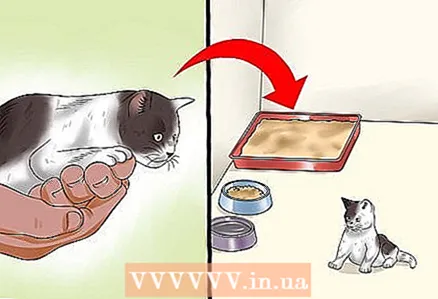 2 Begin to periodically separate the kittens from the mother. At 4 weeks old, you can start picking up the kitten from the mother for a few hours. At the same time, place the kitten in a place where it will have its own litter box, bowls of food and water.
2 Begin to periodically separate the kittens from the mother. At 4 weeks old, you can start picking up the kitten from the mother for a few hours. At the same time, place the kitten in a place where it will have its own litter box, bowls of food and water. 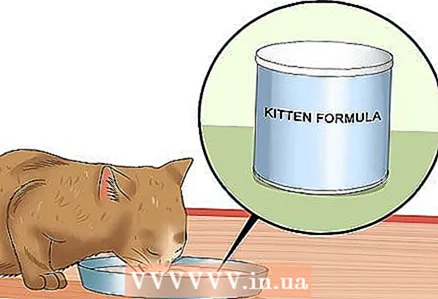 3 Teach your kitten to lap milk on its own by pouring cat milk replacer into a shallow bowl. Place your finger under the milk first. The kitten will first try to suck on your finger, but will instinctively figure out that it is easier to lick your finger than to suck.
3 Teach your kitten to lap milk on its own by pouring cat milk replacer into a shallow bowl. Place your finger under the milk first. The kitten will first try to suck on your finger, but will instinctively figure out that it is easier to lick your finger than to suck. - Do not give your kitten cow's milk, as it can lead to digestive upset.
 4 Enter solid feed. When the kitten learns to lap milk, it's time to introduce him to solid, wet food. You need to start with the consistency of a thin porridge and gradually reduce the amount of moisture in the food until the kitten reaches 8-10 weeks, when he can safely eat dry food.
4 Enter solid feed. When the kitten learns to lap milk, it's time to introduce him to solid, wet food. You need to start with the consistency of a thin porridge and gradually reduce the amount of moisture in the food until the kitten reaches 8-10 weeks, when he can safely eat dry food. - To prepare the gruel, mix dry or canned cat food with the cat milk replacer until you get the consistency of a thin gruel.
- Gradually reduce the amount of milk replacer added daily up to 6 weeks, when the kitten's food should be only slightly damp.
- By about 8-10 weeks, the kitten should learn to eat dry food.
Method 3 of 5: Making Weaning Easier for Your Cat
 1 Do not separate a cat from all kittens at once. It is more beneficial for the cat to gradually decrease milk production. If you take away all the kittens from her at once, then she will feel painful sensations due to the overflow of milk.
1 Do not separate a cat from all kittens at once. It is more beneficial for the cat to gradually decrease milk production. If you take away all the kittens from her at once, then she will feel painful sensations due to the overflow of milk.  2 Remove from the cat anything that smells like kittens. The lingering smell of kittens can remind the cat to check them out, while she can wander around the house looking for them. Once all the kittens have found new homes for themselves, it’s better for you to remove all scent items and provide the cat with a clean bedding. Along with the gradual disappearance of the smell of kittens from the environment, the cat's instinctive desire to find kittens will fade away, and she will again be able to return to normal life.
2 Remove from the cat anything that smells like kittens. The lingering smell of kittens can remind the cat to check them out, while she can wander around the house looking for them. Once all the kittens have found new homes for themselves, it’s better for you to remove all scent items and provide the cat with a clean bedding. Along with the gradual disappearance of the smell of kittens from the environment, the cat's instinctive desire to find kittens will fade away, and she will again be able to return to normal life.  3 Be aware that your cat will recover quickly enough from separation from kittens. Nature itself has laid in the cat the understanding that kittens must become independent in order to survive. As part of this process, she will begin to distance herself from the kittens so that they can be their own support. The transfer of kittens to new owners only accelerates this process.
3 Be aware that your cat will recover quickly enough from separation from kittens. Nature itself has laid in the cat the understanding that kittens must become independent in order to survive. As part of this process, she will begin to distance herself from the kittens so that they can be their own support. The transfer of kittens to new owners only accelerates this process. - If, when weaning kittens, they are old enough (preferably 12-13 weeks old), and their smell is removed from the old house, the cat will experience only a day or two before returning to its normal life.
Method 4 of 5: Introducing a Kitten to a New Home
 1 Provide the kitten with bedding from the old house. Prepare in advance for the kitten a towel or blanket on which he slept in the old house. Having a familiar scent will make it easier for the kitten to adapt. Place this blanket or towel in the carrier when the kitten is being moved to the new home and leave it to him to continue sleeping on.
1 Provide the kitten with bedding from the old house. Prepare in advance for the kitten a towel or blanket on which he slept in the old house. Having a familiar scent will make it easier for the kitten to adapt. Place this blanket or towel in the carrier when the kitten is being moved to the new home and leave it to him to continue sleeping on.  2 Bring the kitten to the new home in a carrier. Carrying will allow the kitten to feel safe and protected. Place a towel in the carrier to warm up and absorb urine in case of an oversight.
2 Bring the kitten to the new home in a carrier. Carrying will allow the kitten to feel safe and protected. Place a towel in the carrier to warm up and absorb urine in case of an oversight. - Do not use a carrier from another pet, as the smell of another pet will stress the kitten.
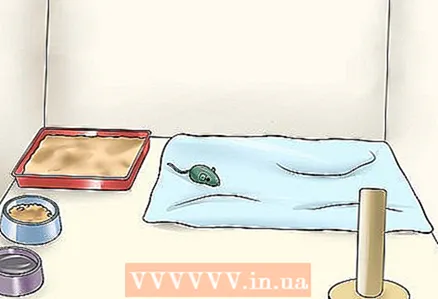 3 Provide the kitten with a safe enclosure. Give your kitten a small, confined space. This place should be quiet and peaceful. At the same time, the kitten should have bedding, food, water and a litter box, as well as a scratching post and toys that are safe for him.
3 Provide the kitten with a safe enclosure. Give your kitten a small, confined space. This place should be quiet and peaceful. At the same time, the kitten should have bedding, food, water and a litter box, as well as a scratching post and toys that are safe for him. - Whether you will be using a cardboard box for bedding or buying it ready-made from a pet store, consider covering it with your old sweater to help the kitten get used to the new owner's scent.
- Check that the space provided to the kitten has a place where he can hide. If there is no furniture in this place to hide behind, place the kitten boxes with holes cut in them so that he can climb into them.
 4 Let the kitten explore the space given to it at its own speed. Bring the carrier to this place, open the door and let the kitten go out on his own when he is ready for it. Leave the carrier for the kitten as another hiding place.
4 Let the kitten explore the space given to it at its own speed. Bring the carrier to this place, open the door and let the kitten go out on his own when he is ready for it. Leave the carrier for the kitten as another hiding place.  5 Limit communication with the kitten during the first week. You will most likely want to hold it in your hands and iron it for a long time. This should not be done. It takes a kitten time to get used to a new environment, including people. Introduce the kitten to the family members one at a time, take your time, let the kitten approach the person on its own.
5 Limit communication with the kitten during the first week. You will most likely want to hold it in your hands and iron it for a long time. This should not be done. It takes a kitten time to get used to a new environment, including people. Introduce the kitten to the family members one at a time, take your time, let the kitten approach the person on its own. - Be sure to teach your children how to properly handle the kitten, including how to handle it properly.
- Do not let children under 5 years old play with the kitten. It is not safe for him.
 6 Introduce the kitten to the rest of the house as soon as he gets used to his pen. When the kitten is good at eating, drinking and going to the litter box regularly, start introducing him to the other rooms in his house one at a time.Place the kitten in the carrier and bring it to another room, leaving the carrier open for the kitten to look around. After the kitten has examined the room, take him back to his pen for at least a few hours before letting him explore the next room.
6 Introduce the kitten to the rest of the house as soon as he gets used to his pen. When the kitten is good at eating, drinking and going to the litter box regularly, start introducing him to the other rooms in his house one at a time.Place the kitten in the carrier and bring it to another room, leaving the carrier open for the kitten to look around. After the kitten has examined the room, take him back to his pen for at least a few hours before letting him explore the next room. - If the kitten climbs on something (shelf, bed, etc.) that it is not supposed to climb, carefully remove it and put it on the floor. If you do this from the very first day, it will be much easier for you to set the boundaries of acceptable behavior for the kitten.
 7 Continue to feed the kitten with the same food that was used when weaned him so that he does not have problems. Providing the kitten with the food he is accustomed to will make him more comfortable and avoid digestive upset caused by the gut bacteria needing to adapt to the new food.
7 Continue to feed the kitten with the same food that was used when weaned him so that he does not have problems. Providing the kitten with the food he is accustomed to will make him more comfortable and avoid digestive upset caused by the gut bacteria needing to adapt to the new food. - Prepare in advance and ask the person from whom you buy the kitten what kind of food he feeds him so that you can stock up on ready-made food by the time the kitten arrives at your home.
 8 Consider using a feline pheromone electrofumigator to reduce anxiety in your kitten. The cat's facial glands are capable of producing pheromones (chemical signals), which they transfer to objects that seem safe to them; for example, they can apply them to a bed, chair, or even your legs. There are special electrofumigators with synthetic analogs of these pheromones, which allow the cat to feel safe in a new place. One bottle of pheromones for a fumigator is usually enough for about 30 days, which is quite enough for a kitten to fully adapt to a new environment.
8 Consider using a feline pheromone electrofumigator to reduce anxiety in your kitten. The cat's facial glands are capable of producing pheromones (chemical signals), which they transfer to objects that seem safe to them; for example, they can apply them to a bed, chair, or even your legs. There are special electrofumigators with synthetic analogs of these pheromones, which allow the cat to feel safe in a new place. One bottle of pheromones for a fumigator is usually enough for about 30 days, which is quite enough for a kitten to fully adapt to a new environment. - The most common pheromone remedy is felivay. It is sold both in the form of a liquid for an electrofumigator, which plugs into an outlet and automatically distributes pheromones, and in the form of a regular spray.
Method 5 of 5: Arranging for a New Kitten to Meet an Old Cat
 1 Introduce your new kitten to your old cat gradually. If the kitten has been properly socialized and moved into a new home at around 12-13 weeks of age, it should be easy for him to get used to the new home. However, if another cat already lives in this house, then you should introduce them gradually.
1 Introduce your new kitten to your old cat gradually. If the kitten has been properly socialized and moved into a new home at around 12-13 weeks of age, it should be easy for him to get used to the new home. However, if another cat already lives in this house, then you should introduce them gradually.  2 Give your kitten a pen in an area that is rarely used by an older cat. This will unobtrusively let the cat understand that a kitten has appeared on her territory, but he does not compete with her for food and favorite resting places (belonging only to her).
2 Give your kitten a pen in an area that is rarely used by an older cat. This will unobtrusively let the cat understand that a kitten has appeared on her territory, but he does not compete with her for food and favorite resting places (belonging only to her).  3 First, introduce the old cat only to the kitten scent. Your cats can sniff each other through the crack under the door of the kitten's room. You can swap pets' bedding so that they get used to each other's scent. It also helps by stroking one pet first and then another to mix their smells.
3 First, introduce the old cat only to the kitten scent. Your cats can sniff each other through the crack under the door of the kitten's room. You can swap pets' bedding so that they get used to each other's scent. It also helps by stroking one pet first and then another to mix their smells. - Be sure to pay special attention to your old cat to reduce her anxiety. If you ignore her and give your full attention to the kitten, it will create problems for you.
 4 Feed the cats on either side of the door that separates them. This will allow them to develop an association of a new smell with something good, namely, food.
4 Feed the cats on either side of the door that separates them. This will allow them to develop an association of a new smell with something good, namely, food. 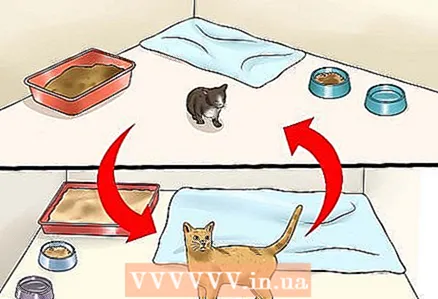 5 When the kitten gets used to its pen, change places with the cat. While your new kitten is exploring the rest of your house, put your old cat in its place. This will allow pets to explore each other's smells in new places.
5 When the kitten gets used to its pen, change places with the cat. While your new kitten is exploring the rest of your house, put your old cat in its place. This will allow pets to explore each other's smells in new places. 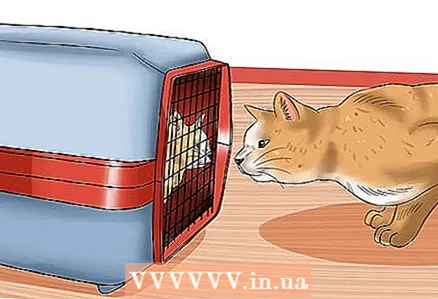 6 Once the kitten has completely adjusted to the new home, allow the cats to meet. Place a barrier between the cats, or keep the kitten in a carrier so that it cannot jump on an older cat that may consider it an insult. Let them get used to each other by letting them sniff and touch their noses through the carrier grill. You need to wait until the moment when the old cat becomes indifferent to the kitten and simply moves away from him, this will serve as a sign that she has adopted him.
6 Once the kitten has completely adjusted to the new home, allow the cats to meet. Place a barrier between the cats, or keep the kitten in a carrier so that it cannot jump on an older cat that may consider it an insult. Let them get used to each other by letting them sniff and touch their noses through the carrier grill. You need to wait until the moment when the old cat becomes indifferent to the kitten and simply moves away from him, this will serve as a sign that she has adopted him. - If any of the cats show obvious hostility (hiss, try to scratch or bite), give her more time to get used to the presence of the other pet by placing the kitten back in his pen.
 7 If cats don't get along, try feeding them together. First, place bowls of food for them in opposite corners of the room. Gradually bring the bowls closer together. The idea is to build an associative link between the presence of another pet and feeding.
7 If cats don't get along, try feeding them together. First, place bowls of food for them in opposite corners of the room. Gradually bring the bowls closer together. The idea is to build an associative link between the presence of another pet and feeding. 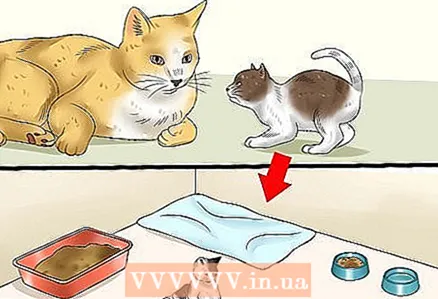 8 Separate the kitten from the old cat if he is overly active with her. After the old cat accepts the kitten, you can leave it to roam freely around the house. However, it is important to keep an eye on him, especially when he is around an old cat.
8 Separate the kitten from the old cat if he is overly active with her. After the old cat accepts the kitten, you can leave it to roam freely around the house. However, it is important to keep an eye on him, especially when he is around an old cat. - If the kitten starts playing with the old cat and becomes overly violent, put it in a separate room so that the old cat has some advantage in its territory.
Tips
- Remember that in nature, a mother cat instinctively drives away grown kittens, prompting them to live independently, and when you give kittens to new owners, in the eyes of the cat you are doing everything right.
Additional articles
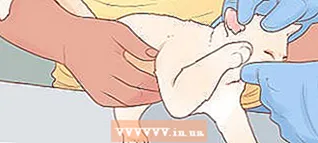 How to care for kittens
How to care for kittens  How to tell if your cat is pregnant
How to tell if your cat is pregnant  How to sleep a hyperactive kitten
How to sleep a hyperactive kitten  How to care for kittens without a cat in the first 3 weeks
How to care for kittens without a cat in the first 3 weeks  How to calm a kitten to stop screaming
How to calm a kitten to stop screaming  How to make your cat love you
How to make your cat love you  How to find a missing cat
How to find a missing cat  How to train your cat to swim
How to train your cat to swim  How to find a cat that has hidden
How to find a cat that has hidden  How to bring a second cat home and not upset the first
How to bring a second cat home and not upset the first  How to bury a cat
How to bury a cat  How to make friends with a cat and a dog
How to make friends with a cat and a dog  How to immobilize a cat
How to immobilize a cat  How to catch a stray kitten
How to catch a stray kitten



